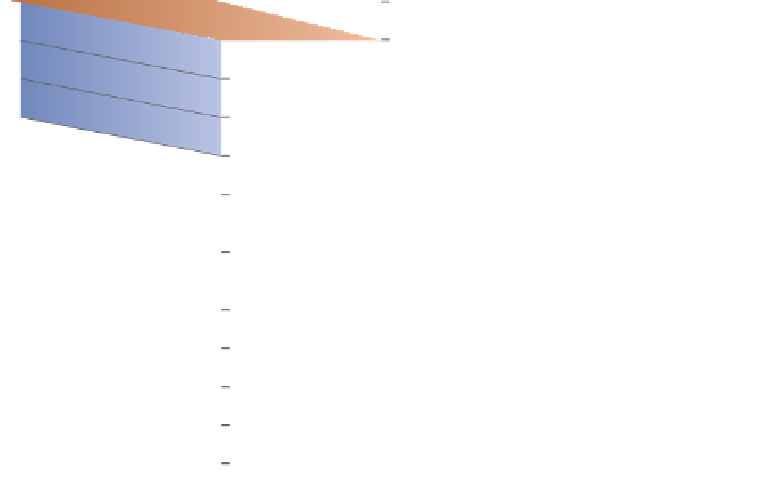Geology Reference
In-Depth Information
thickness of sedimentary rock in
its crust. Rates of deposition vary,
however, even for the same type of
rock. Furthermore, it is impossible
to estimate how much of a rock
has been removed by erosion, or
how much a rock sequence has
been reduced by compaction. As
a result of these variables, esti-
mates of Earth's age ranged from
younger than 1 million years to
older than 2 billion years.
Another attempt to deter-
mine Earth's age involved ocean
salinity. Scholars assumed that
Earth's ocean waters were origi-
nally fresh and that their pres-
ent salinity was the result of
dissolved salt being carried into
the ocean basins by streams.
Knowing the volume of ocean
water and its salinity, John Joly,
a 19th-century Irish geologist,
measured the amount of salt
currently in the world's streams.
He then calculated that it would
have taken at least 90 million
years for the oceans to reach
their present salinity level. This
was still much younger than the
now-accepted age of 4.6 billion
years for Earth, mainly because
Joly had no way to calculate
either how much salt had been
recycled or the amount of salt
stored in continental salt depos-
its and seafl oor clay deposits.
Besides trying to determine
Earth's age, the naturalists of the
18th and 19th centuries were for-
mulating some of the fundamen-
tal geologic principles that are
used in deciphering Earth history.
From the evidence preserved in
the geologic record, it was clear
to them that Earth is very old and
that geologic processes have operated over long periods of time.
A good example of geologic processes operating over long peri-
ods of time to produce a spectacular landscape is the evolution of
Uluru and Kata Tjuta (see Geo-inSight on pages 456 and 457).
Eon
Era
Period
Epoch
Recent or
Holocene
Pleistocene
Millions of
Years Ago
0
0.01
Pliocene
1.8
Miocene
5
Oligocene
23
Eocene
34
Paleocene
56
Cretaceous
66
Jurassic
146
Triassic
200
Permian
251
Pennsylvanian
299
Mississippian
318
Devonian
359
Silurian
416
Ordovician
444
Cambrian
488
542
2500
4600
◗
Figure 17.1
The Geologic Time Scale Some of the major geologic and biologic events are
indicated for the various eras, periods, and epochs. Dates are from Gradstein, F., Ogg, J., and Smith,
A.,
A Geologic Timescale 2004
(Cambridge, UK: Cambridge University Press, 2005), Figure 1.2.
To simulate this history, he melted iron balls of various diame-
ters and allowed them to cool to the surrounding temperature.
By extrapolating their cooling rate to a ball the size of Earth, he
determined that Earth was at least 75,000 years old. Although
this age was much older than that derived from Scripture, it
was vastly younger than we now know our planet to be.
Other scholars were equally ingenious in attempting to
calculate Earth's age. For example, if deposition rates could be
determined for various sediments, geologists reasoned that they
could calculate how long it would take to deposit any rock layer.
They could then extrapolate how old Earth was from the total
JAMES HUTTON AND THE
Many consider the Scottish geologist James Hutton (1726-
1797) to be the father of modern geology. His detailed stud-
ies and observations of rock exposures and present-day

















Search WWH ::

Custom Search